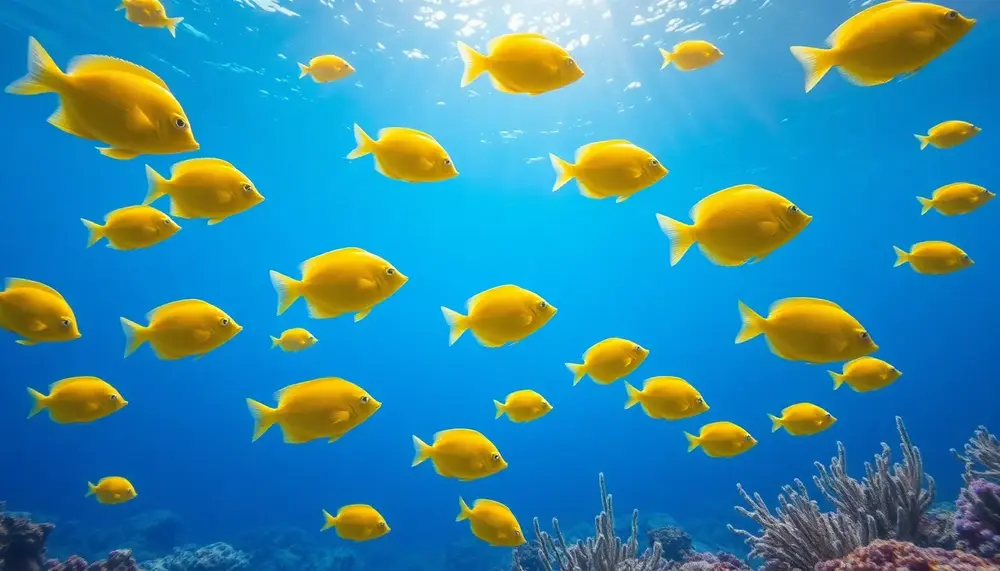Table of Contents:
Introduction to Yellow Fish Species
Yellow fish species captivate aquarists and marine enthusiasts alike, thanks to their vibrant colors and distinct characteristics. These fish are not just visually appealing; they also play significant roles in their ecosystems. The bright yellow coloration often serves multiple purposes, including attracting mates and warning predators. Furthermore, these species can be found across various habitats, from coral reefs to freshwater lakes, showcasing their adaptability and diversity.
In the world of ichthyology, yellow fish represent a fascinating group that highlights the beauty and complexity of aquatic life. Their color can be attributed to specific pigments and structural coloration, which can change depending on the environment or emotional state of the fish. This dynamic nature adds another layer of intrigue to their study.
Moreover, yellow fish species are essential indicators of environmental health. For instance, the presence of certain yellow species can signal the quality of the surrounding habitat, particularly in coral reef ecosystems. This makes them not only a delight for aquarium owners but also important players in the health of marine biodiversity.
As we delve deeper into the world of yellow fish, we will explore various species, their unique traits, and the environments they inhabit. Understanding these fish provides valuable insights into the intricate balance of aquatic ecosystems and the need for conservation efforts to protect their habitats.
Characteristics of Yellow Fish
Yellow fish are not just visually striking; they possess a range of characteristics that make them unique within the aquatic world. Understanding these traits provides insights into their behavior, ecology, and role in their environments.
- Coloration: The bright yellow hue in these fish can result from specific pigments, such as carotenoids, and structural coloration. This vibrant color often serves as a form of communication, signaling health and vitality to potential mates.
- Body Shape: Yellow fish exhibit a variety of body shapes, ranging from the elongated forms of some species like the Chinese trumpetfish to the more compact shapes of cichlids. This diversity in morphology often correlates with their feeding habits and habitat preferences.
- Behavior: Many yellow fish display intriguing behaviors, including complex mating rituals and social interactions. For instance, some species may use their coloration to establish dominance or attract mates during spawning seasons.
- Diet: The dietary habits of yellow fish vary widely. Some are herbivorous, grazing on algae, while others are carnivorous, preying on smaller fish and invertebrates. Their feeding strategies are often adapted to their specific environments, whether it’s a coral reef or a freshwater lake.
- Habitat Adaptations: Yellow fish are found in diverse habitats, which has led to various adaptations. Some species thrive in shallow reef areas, utilizing their coloration for camouflage among corals, while others may inhabit deeper waters, relying on different survival strategies.
- Reproductive Strategies: Reproduction among yellow fish can be quite complex. Many species engage in elaborate courtship displays, where coloration plays a crucial role in attracting partners. Fertility rates and breeding behaviors can vary significantly, influenced by environmental conditions.
These characteristics not only highlight the adaptability and resilience of yellow fish but also emphasize their ecological importance. As we continue to study these fascinating creatures, we gain a better understanding of the intricate relationships within aquatic ecosystems.
Top 10 Yellow Fish Species
Exploring the vibrant world of yellow fish, we uncover a variety of species that not only showcase stunning colors but also exhibit unique traits and behaviors. Below is a closer look at the top 10 yellow fish species, each remarkable in its own right:
- Longhorn Cowfish (Lactoria cornuta): Known for its distinctive long horns and boxy shape, this species can reach sizes of up to 50 cm. It thrives in the warm waters of the Indo-Pacific and is recognized for its slow swimming and unique defensive mechanisms, including toxin production.
- Chinese Trumpetfish (Aulostomus chinensis): This elongated fish can grow between 60 cm and 80 cm. Its slender body aids in camouflage among coral reefs, allowing it to ambush prey effectively. Found in the Indo-Pacific region, it exhibits color changes during mating rituals.
- Bluecheek Butterflyfish (Chaetodon semilarvatus): With a size range of 15 cm to 23 cm, this species is a colorful inhabitant of the Red Sea. Its bright yellow body accented with orange stripes makes it a popular choice for aquarists. They are often seen in pairs, showcasing a peaceful demeanor.
- Electric Yellow Cichlid (Labidochromis caeruleus): A staple in freshwater aquariums, this species reaches 7 cm to 13 cm and is native to Lake Malawi. Its bright yellow coloration is not only visually stunning but also plays a role in its social interactions within its habitat.
- Longsnout Seahorse (Hippocampus reidi): While specific details about size and lifespan remain elusive, this species is known for its long snout and yellowish hue. They are often found in shallow waters and are highly sought after for their unique appearance.
- Yellow Tang (Zebrasoma flavescens): A favorite in marine aquariums, this species is easily recognized by its vibrant yellow color and distinctive disc shape. They are generally found in Hawaiian waters, where they inhabit coral reefs and feed on algae.
- Yellow Boxfish (
FAQ About Yellow Fish Species
What are some common yellow fish species?
Some common yellow fish species include the Longhorn Cowfish, Yellow Tang, Electric Yellow Cichlid, Bluecheek Butterflyfish, and Foxface Rabbitfish.
What habitats do yellow fish prefer?
Yellow fish are typically found in diverse habitats, including coral reefs, shallow coastal waters, and freshwater lakes, depending on the species.
Why do yellow fish have bright coloration?
The bright coloration in yellow fish serves multiple purposes, including attracting mates, warning predators of toxicity, and providing camouflage in their natural environments.
How do yellow fish contribute to their ecosystem?
Yellow fish play vital roles in their ecosystems by controlling algal growth, maintaining coral reef health, and serving as indicators of environmental quality.
What are the care requirements for yellow fish in aquariums?
Yellow fish require specific care, including a well-maintained aquarium, stable water quality, a varied diet, and adequate space with hiding spots to thrive.







